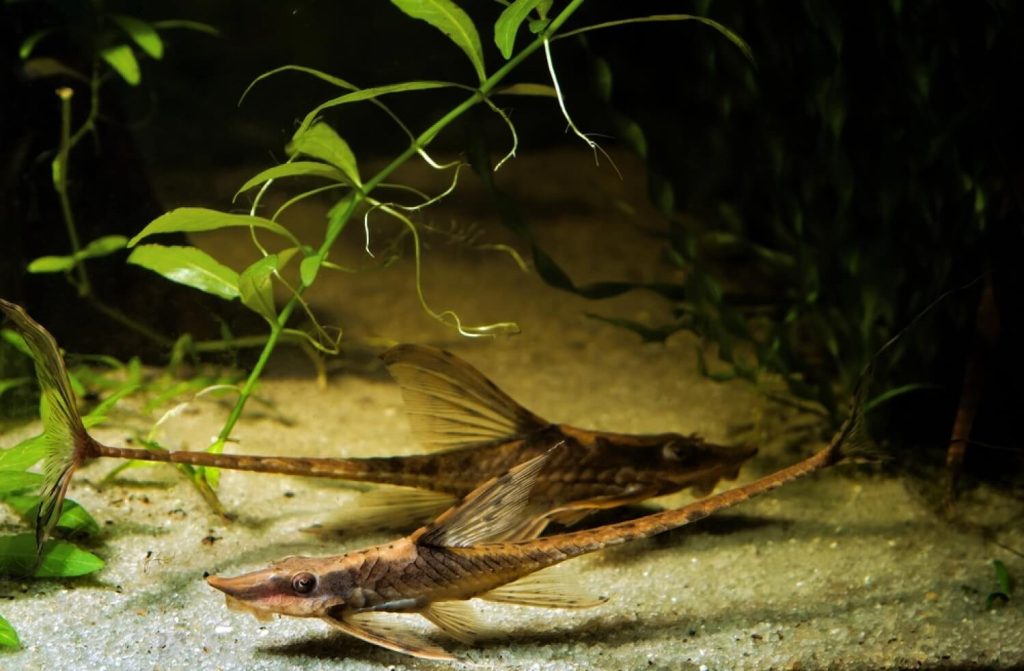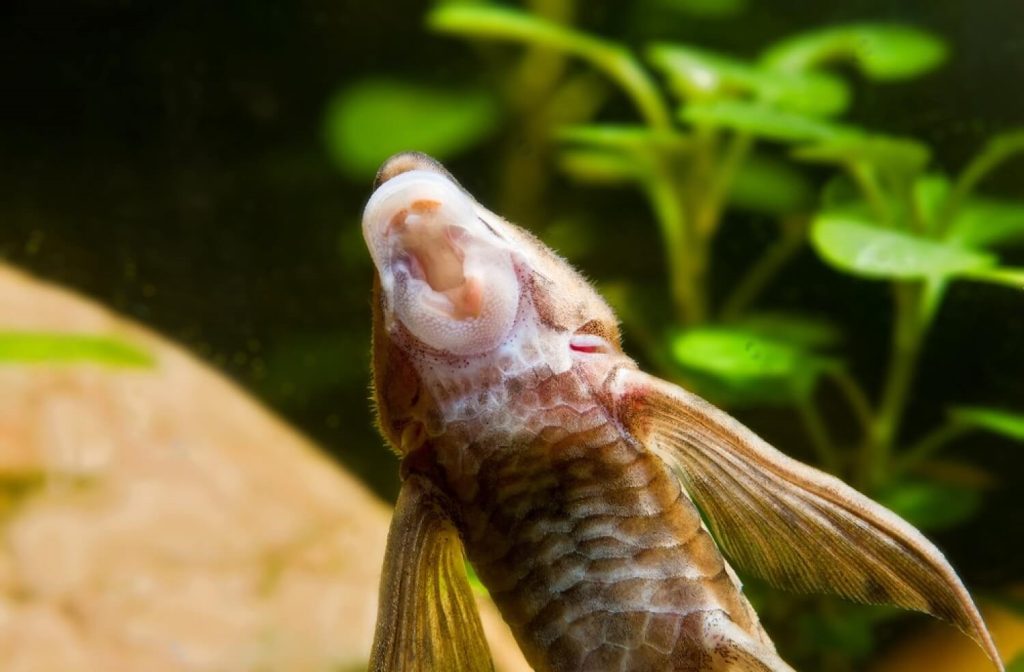If you find yourself captivated by aquariums and long for an extraordinary addition that sets your collection apart from others then let us introduce you to the intriguing world of whiptail catfish. Celebrated for its distinct appearance coupled with a peaceful temperament this remarkable aquatic creature has garnered immense popularity amongst enthusiasts worldwide. Our objective in this piece is to enlighten you about crucial details such as their size, suitable tank companionship options along with specific environmental prerequisites essential for their contentment within a confined habitat. Moreover, we shall also unravel the correlation existing between chameleons and royal whiptail catfish.

Table of Contents
Whiptail Catfish Size and Max Size
Generally, they range between 3 to 6 inches in length, making them ideal for medium-sized aquariums. However, it is important to note that some species can grow up to 8 inches. One example is the Royal Whiptail Catfish (Rineloricaria royal), which reaches its maximum size of around 8 inches. As responsible fishkeepers, it is crucial to consider the potential growth of these catfish when planning their habitat.
Whiptail Catfish Tank Mates
When setting up an aquarium, one of the key considerations is selecting suitable tank mates for your fish. Whiptail catfish, with their peaceful nature and unique appearance, can thrive in a community tank with compatible companions.
Factors to Consider
- Compatibility: Select fish species that share similar temperament and water parameter requirements.
- Size: Choose tank mates that are similar in size or smaller than the whiptail catfish to avoid potential aggression or predation.
- Activity Level: Opt for calm and peaceful fish species that won’t stress or harass them.
- Habitat Preferences: Consider the preferred swimming level and habitat of potential tank mates to ensure each species has ample space and hiding spots.
1. Corydoras Catfish
Corydoras catfish are an ideal choice for tank mates, especially those that inhabit the same region as whiptail catfish in the wild. These bottom-dwelling catfish share similar temperaments and habitat preferences, making them great companions. Choose species like the Bronze Corydoras (Corydoras aeneus) or Panda Corydoras (Corydoras panda) that have peaceful behavior and thrive in similar water conditions.
2. Tetras
Tetras are a popular choice for community tanks due to their vibrant colors and peaceful nature. Whiptail catfish can coexist harmoniously with various tetra species. Consider adding Neon Tetras (Paracheirodon innesi), Cardinal Tetras (Paracheirodon axelrodi), or Ember Tetras (Hyphessobrycon amandae) to create a lively and colorful aquarium community.
3. Gouramis
Gouramis are another suitable option for whiptail catfish tank mates. These peaceful labyrinth fish come in a range of colors and sizes. Honey Gouramis (Trichogaster chuna), Dwarf Gouramis (Trichogaster lalius), and Pearl Gouramis (Trichopodus leerii) are known for their calm demeanor and compatibility with other species. Ensure the tank provides enough space and hiding spots for both the gouramis and the whiptail catfish.
4. Rasboras
Rasboras are small, peaceful fish that can create a lively and active community in your aquarium. Harlequin Rasboras (Trigonostigma heteromorpha) and Chili Rasboras (Boraras brigittae) are popular choices that thrive in similar water conditions as whiptail catfish. These schooling fish will add movement and color to the tank while coexisting peacefully with their tank mates.
5. Dwarf Cichlids
If you’re looking to add some character to your aquarium, consider dwarf cichlids as whiptail catfish tank mates. Apistogramma species, such as the Apistogramma cacatuoides or Apistogramma borellii, are known for their vibrant colors and intriguing behavior. These smaller cichlids have peaceful temperaments and can coexist with whiptail catfish as long as the tank provides sufficient hiding places and territories.
6. Livebearers
Livebearers like guppies, mollies, and platies are versatile and adaptable fish that can thrive alongside whiptail catfish. These species are easy to care for, and their lively swimming patterns add movement to the aquarium. However, keep in mind that some male livebearers may exhibit territorial behavior, so it’s best to maintain a proper male-to-female ratio to prevent aggression.
7. Schooling Fish
Adding a school of small, peaceful fish to your aquarium can create a stunning visual display. Species like Harlequin Rasboras (Trigonostigma heteromorpha), Glowlight Tetras (Hemigrammus erythrozonus), or Celestial Pearl Danios (Danio margaritatus) can coexist harmoniously with whiptail catfish. These active and sociable fish will thrive in a well-planted tank, providing a dynamic and engaging aquatic community.
Whiptail Catfish Tank Size

To provide a comfortable living environment for your whiptail catfish, consider the tank size carefully. As these catfish can grow up to 8 inches, a minimum tank size of 30 gallons is recommended for a single adult. However, if you plan to keep a small group, aim for a larger tank to accommodate their potential growth and allow ample swimming space. It is essential to maintain a well-filtered aquarium with suitable water parameters to promote their health and well-being.
Chameleon and Royal Whiptail Catfish
The relationship between chameleons and royal whiptail catfish is an intriguing phenomenon observed by some reptile enthusiasts. Chameleons, known for their unique ability to change color and adapt to their environment, are often kept in terrariums with plants and other natural elements. In these setups, some aquarists have noticed that chameleons exhibit a sense of calmness and security when royal whiptail catfish are introduced to the habitat.
The royal whiptail catfish, with its elegant movements and distinctive appearance, seems to captivate the attention of chameleons. Chameleons, being naturally inquisitive creatures, are stimulated by the presence of the catfish as they glide gracefully through the water. The chameleons are often observed closely observing the catfish, seemingly mesmerized by their movements.
Furthermore, the catfish’s peaceful nature and non-aggressive behavior contribute to the compatibility between the two species. The chameleons perceive the catfish as non-threatening, which creates a harmonious atmosphere within the terrarium. This interaction can provide enrichment for both the chameleons and the royal whiptail catfish, as they coexist in a symbiotic relationship.
Conclusion
The whiptail catfish is an excellent addition to any aquarium. With their unique appearance, peaceful nature, and compatibility with a variety of tank mates, they bring beauty and harmony to aquatic environments.
Additionally, the intriguing relationship between chameleons and royal whiptail catfish adds an extra layer of fascination to the world of aquarium keeping. Observing the calming effect these catfish have on chameleons can be a rewarding experience for reptile enthusiasts.
So, if you’re looking for a captivating and peaceful fish to enhance your aquarium, consider adding the mesmerizing whiptail catfish. Your aquatic ecosystem will thrive with their presence, providing you with endless hours of joy and tranquility.
FAQs
- Q: Do whiptail catfish require a specific type of water? A: They prefer soft and slightly acidic water conditions. It is important to maintain suitable water parameters for their health.
- Q: Can whiptail catfish live with aggressive fish species? A: It is generally not recommended to house them with aggressive fish species as they may become stressed or injured. Choose peaceful tank mates instead.
- Q: How often should I feed my whiptail catfish? A: They are omnivorous and should be fed a balanced diet of high-quality pellets, flakes, and occasional live or frozen foods. Feed them once or twice a day.
- Q: Are whiptail catfish suitable for beginner fishkeepers? A: They can be suitable for beginners, provided they meet their specific requirements and maintain a well-established aquarium with proper filtration.
Recommended Reading: Aquascape Ideas: Enhancing Your Underwater World



